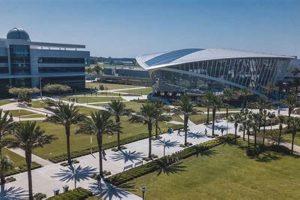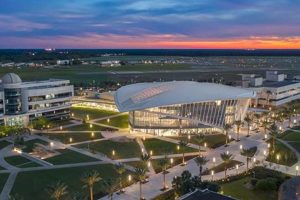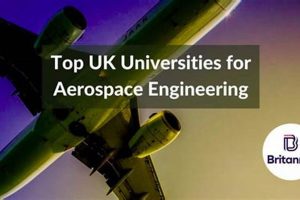Institutions offering superior education and research opportunities in the field encompassing the design, development, testing, and production of aircraft and spacecraft are paramount for advancing the aerospace sector. These establishments provide specialized curricula, cutting-edge facilities, and access to prominent experts, shaping the next generation of engineers, scientists, and leaders. For instance, universities renowned for their aerospace programs often feature wind tunnels, propulsion labs, and advanced simulation software, enabling students to gain practical experience alongside theoretical knowledge.
The importance of these institutions extends beyond academia. They serve as crucial innovation hubs, contributing significantly to technological advancements, economic growth, and national security. Historically, government agencies and private companies have heavily relied on research conducted at these universities to develop new aircraft, spacecraft, and related technologies. The graduates of these programs are highly sought after, filling critical roles in various sectors, including commercial aviation, space exploration, and defense.
The following sections will examine the key factors that contribute to an institution’s standing in aerospace education, highlighting some of the leading global examples and exploring the characteristics that set them apart. Further discussion will encompass the significance of research funding, industry partnerships, and alumni networks in shaping the excellence of these academic powerhouses.
Guidance for Aspiring Aerospace Professionals
Selecting an appropriate academic institution is a foundational step toward a successful career in aerospace. The following tips are designed to assist prospective students in making informed decisions regarding their higher education path.
Tip 1: Prioritize Accreditation and Program Rankings: Ensure that the chosen university’s aerospace programs hold accreditation from recognized professional organizations. Consult reputable rankings from publications and educational review boards that assess program quality based on faculty expertise, research output, and student outcomes.
Tip 2: Evaluate Research Opportunities: Investigate the availability of research opportunities aligned with specific interests. Leading institutions typically offer diverse research projects, ranging from aerodynamics and propulsion to materials science and space systems engineering. Participation in research provides invaluable hands-on experience and can lead to publications and conference presentations.
Tip 3: Assess Faculty Expertise and Resources: Research the faculty’s qualifications, research backgrounds, and industry experience. A strong faculty with active research programs and established connections to the aerospace industry is crucial. Also, assess the availability of specialized resources, such as wind tunnels, flight simulators, and advanced computing facilities.
Tip 4: Consider Industry Partnerships and Internship Programs: Identify institutions with strong partnerships with aerospace companies and government agencies. These partnerships often translate into internship opportunities, which provide practical experience and potential pathways to employment after graduation.
Tip 5: Examine Curriculum Breadth and Depth: Review the curriculum to ensure it covers a broad range of aerospace disciplines, including aerodynamics, structures, propulsion, control systems, and space engineering. Look for opportunities to specialize in areas of interest through elective courses and research projects.
Tip 6: Analyze Location and Networking Opportunities: Consider the university’s location and its proximity to aerospace industry hubs. Being situated near aerospace companies or research centers can facilitate networking and career opportunities. Attend university events and connect with alumni working in the field.
Tip 7: Investigate Funding and Scholarship Options: Explore available scholarships, fellowships, and grants to help offset the cost of tuition and living expenses. Many universities offer merit-based and need-based financial aid packages specifically for aerospace students. Additionally, investigate external funding sources from government agencies and private organizations.
By carefully considering these factors, prospective students can increase their likelihood of selecting a university that will provide a strong foundation for a rewarding career in the dynamic field of aerospace. Making an informed decision about one’s education directly influences future professional success and contributions to the advancement of aerospace technology.
The following section will delve into the specific attributes and program highlights that define exceptional institutions within the global aerospace education landscape.
1. Research Funding
Research funding is a cornerstone of preeminent aerospace educational institutions. These financial resources enable universities to undertake complex projects that drive innovation in areas such as propulsion, aerodynamics, materials science, and space systems. The correlation between high levels of research funding and the caliber of an aerospace university is direct: substantial funding attracts leading faculty, facilitates access to cutting-edge equipment, and empowers researchers to pursue ambitious projects that yield significant advancements. As a consequence, these institutions become magnets for talented students seeking opportunities to contribute to groundbreaking research.
The influence of research funding extends to the quality of educational programs. Funded research projects offer students hands-on experience, enhancing their understanding of theoretical concepts and developing practical skills essential for their future careers. For example, universities receiving grants from agencies such as NASA or the European Space Agency can offer students opportunities to participate in mission design, spacecraft development, or data analysis. These experiences are invaluable for shaping well-rounded aerospace professionals ready to address the challenges of the industry. Moreover, research funding facilitates the acquisition of advanced facilities, including wind tunnels, propulsion test stands, and high-performance computing clusters, further enriching the learning environment.
In conclusion, research funding plays a pivotal role in shaping leading aerospace universities. It fosters innovation, attracts top talent, enhances educational programs, and facilitates access to state-of-the-art facilities. While securing and managing research funding presents ongoing challenges, the benefits for universities and their students are undeniable. The pursuit of research funding is, therefore, an essential element in maintaining and elevating the standing of institutions aspiring to be among the best in aerospace education and research.
2. Faculty Expertise
Faculty expertise constitutes a fundamental pillar upon which the reputation and efficacy of aerospace programs are built. At institutions recognized as preeminent in aerospace education, the faculty comprises individuals with profound knowledge, extensive experience, and a demonstrated commitment to advancing the field. The presence of accomplished professors, researchers, and engineers directly correlates with the quality of instruction, research opportunities, and overall learning environment. A faculty possessing expertise in diverse areas, such as aerodynamics, propulsion, structural mechanics, and astrodynamics, ensures students receive comprehensive training and exposure to the breadth of the aerospace discipline.
The practical application of faculty expertise is evident in the curriculum design and research direction within these institutions. For example, professors with experience in developing advanced propulsion systems can incorporate their insights into coursework, providing students with a current understanding of industry trends. Similarly, researchers specializing in composite materials can lead projects exploring new applications for aerospace structures, offering students opportunities to engage in cutting-edge investigations. The faculty’s connections to industry, through consulting roles or collaborative research, further enriches the educational experience by bridging the gap between academia and real-world engineering challenges. A concrete example can be found in universities where faculty members are involved in the design and testing of next-generation aircraft or spacecraft, and subsequently integrate those experiences into their teaching and mentoring activities.
In summation, faculty expertise is not merely an attribute but a critical component of successful aerospace programs. The level of knowledge, experience, and engagement demonstrated by the faculty directly influences the quality of education, the scope of research, and the career preparedness of graduates. Institutions committed to maintaining and enhancing their standing within the aerospace field must prioritize the recruitment, retention, and professional development of faculty members who possess exceptional expertise and a passion for advancing the state of aerospace knowledge and technology.
3. Industry Partnerships
The presence of robust industry partnerships is a defining characteristic of leading aerospace universities. These collaborations serve as critical conduits for knowledge transfer, technological advancement, and workforce development within the aerospace sector. The effect of these partnerships is multi-faceted, providing universities with access to real-world engineering challenges, specialized equipment, and invaluable insights into the evolving needs of the aerospace industry. Consequently, universities can tailor their curricula and research initiatives to align more closely with industry demands, ensuring graduates possess the skills and knowledge necessary for immediate contribution.
A prominent example can be found in collaborative research projects between universities and aerospace companies, where faculty and students work alongside industry experts to address specific technological challenges, such as developing more efficient aircraft engines or designing advanced materials for spacecraft. Furthermore, these partnerships often facilitate internships and co-op programs, allowing students to gain practical experience in industry settings and build professional networks. The benefits extend to industry as well, providing access to university research capabilities, innovative ideas, and a pipeline of talented graduates. For instance, companies may sponsor research projects at universities to explore emerging technologies or improve existing products. Successful collaborations can lead to joint publications, patents, and ultimately, commercialization of new aerospace technologies.
In conclusion, industry partnerships represent an essential component of leading aerospace universities, fostering a symbiotic relationship that benefits both academia and industry. These partnerships drive innovation, enhance the relevance of university programs, and prepare students for successful careers in the aerospace sector. Challenges such as intellectual property rights and differing research priorities must be addressed to ensure productive collaborations. Nevertheless, the strategic cultivation of industry partnerships remains a key factor in maintaining and enhancing the standing of universities aspiring to be at the forefront of aerospace education and research.
4. Program Accreditation
Program accreditation serves as a critical validation of educational quality and rigor within aerospace engineering programs. For institutions aspiring to be recognized among the world’s best, achieving and maintaining accreditation from recognized bodies is not merely a procedural step but a fundamental requirement. Accreditation signifies that a program has undergone a thorough evaluation, confirming adherence to established standards concerning curriculum content, faculty qualifications, facilities, and student outcomes. Consequently, accreditation provides assurance to prospective students, employers, and the public that graduates possess the necessary knowledge and skills to succeed in the aerospace industry. For example, ABET (Accreditation Board for Engineering and Technology) is a widely respected accrediting agency for engineering programs in the United States and internationally. Universities holding ABET accreditation for their aerospace programs demonstrate a commitment to continuous improvement and meeting the evolving needs of the profession.
The practical significance of program accreditation extends to various aspects of a graduate’s career prospects. Many employers in the aerospace sector, including government agencies and leading aerospace companies, prioritize hiring graduates from accredited programs. Accreditation serves as a benchmark of competency, reducing the need for employers to independently assess the qualifications of each applicant. Moreover, accreditation may be a prerequisite for professional licensure or certification, depending on the specific jurisdiction and engineering discipline. In addition, accredited programs often have established pathways for students to pursue advanced degrees or research opportunities. These programs maintain close ties to industry and government research labs, fostering connections and experiential learning opportunities for students.
In conclusion, program accreditation is inextricably linked to the pursuit of excellence in aerospace education. It functions as a quality assurance mechanism, providing stakeholders with confidence in the integrity and effectiveness of accredited programs. While accreditation alone does not guarantee that a university is the “best,” it represents a crucial marker of quality, demonstrating a commitment to meeting industry standards and preparing graduates for successful careers. Universities aiming to achieve recognition as leaders in aerospace education must prioritize obtaining and maintaining accreditation from recognized bodies such as ABET. The pursuit of accreditation reflects dedication to continuous improvement and the delivery of high-quality education to future aerospace professionals.
5. Advanced Facilities
The presence of advanced facilities is a defining characteristic of institutions recognized among the best aerospace universities in the world. These resources, encompassing specialized laboratories, wind tunnels, propulsion test stands, and advanced simulation software, represent a tangible commitment to fostering cutting-edge research and providing students with unparalleled practical training. Access to these facilities enables students and faculty to engage in hands-on experimentation, testing, and analysis that complements theoretical knowledge, accelerating the development of novel aerospace technologies. A direct correlation exists between the sophistication of these facilities and the capacity of a university to attract top researchers, secure competitive funding, and produce graduates who are highly sought after by industry and government agencies.
The practical significance of advanced facilities extends beyond academic research. For instance, universities equipped with state-of-the-art wind tunnels can conduct aerodynamic testing of aircraft designs, contributing to improved fuel efficiency and performance. Institutions possessing advanced propulsion test stands can develop and evaluate new engine technologies, leading to reduced emissions and increased thrust. Through access to high-performance computing clusters and simulation software, aerospace engineers can model complex flight dynamics and analyze the structural integrity of spacecraft, ensuring mission safety and reliability. The integration of these advanced resources into the curriculum allows students to develop the skills and experience required to solve real-world engineering challenges in a rapidly evolving aerospace landscape.
In conclusion, advanced facilities are indispensable to the pursuit of excellence in aerospace education and research. These resources represent a strategic investment in the future of the aerospace industry, enabling universities to drive innovation, attract top talent, and prepare graduates to become leaders in the field. While the acquisition and maintenance of advanced facilities pose significant financial challenges, the benefits they provide in terms of research output, student training, and industry collaboration are undeniable. Thus, the availability and utilization of advanced facilities remain a key indicator of an institution’s standing among the best aerospace universities in the world.
6. Alumni Network
A strong alumni network is a significant indicator of a university’s standing among the best aerospace universities globally. The connection is causal: reputable institutions cultivate successful graduates who, in turn, support their alma mater through various channels. This support includes financial contributions, mentorship opportunities for current students, and professional connections that facilitate career advancement. A robust alumni network serves as an enduring testament to the quality of education and the lasting impact of the institution on its graduates. The presence of accomplished alumni in leadership positions within the aerospace industry, government agencies, and research institutions reflects the university’s effectiveness in producing highly skilled and influential professionals.
The practical significance of a thriving alumni network extends to multiple areas. Firstly, it provides current students with invaluable networking opportunities, internships, and job prospects. Alumni often actively recruit graduates from their alma mater, recognizing the shared educational background and professional values. Secondly, alumni frequently serve as guest lecturers, industry advisors, and mentors, enriching the educational experience by providing real-world insights and practical guidance. Thirdly, alumni contributions, both financial and in-kind, contribute to the university’s resources, enabling investments in facilities, research initiatives, and scholarships. For example, donations from successful alumni have funded the construction of new laboratories, the establishment of endowed professorships, and the creation of student support programs. A real-world example is the substantial contributions from MIT alumni towards the university’s aerospace engineering department, which has significantly boosted its research capabilities and educational offerings.
In summary, the strength of an alumni network is intrinsically linked to the reputation and success of aerospace universities. It provides tangible benefits for current students, enhances the educational environment, and supports the long-term growth of the institution. Challenges in maintaining and expanding alumni engagement exist, including resource constraints and the need for effective communication strategies. However, institutions committed to being recognized as leaders in aerospace education must prioritize the cultivation of a strong and active alumni network as an essential element of their overall strategy. The success of graduates often serves as the most compelling evidence of the quality and impact of the educational institution.
7. Career Placement
Effective career placement is a paramount indicator of success for aerospace programs and a distinguishing characteristic of the top aerospace universities globally. The ability of a university to consistently place its graduates into fulfilling and impactful roles within the aerospace industry, government agencies, and research institutions reflects the quality of its education, the relevance of its research, and the strength of its industry connections. High career placement rates are not merely statistical benchmarks but represent tangible evidence of the university’s commitment to preparing students for successful careers in a competitive field.
- Industry-Aligned Curriculum
Leading aerospace universities design their curricula in close collaboration with industry partners, ensuring that students acquire the knowledge and skills most valued by employers. This alignment includes incorporating real-world engineering challenges into coursework, emphasizing hands-on learning, and providing opportunities for students to work on industry-sponsored projects. The result is a graduate cohort that is readily adaptable and immediately productive in professional settings.
- Internship and Co-op Programs
Top aerospace programs prioritize providing students with practical experience through internships and co-operative education programs. These experiences allow students to apply their theoretical knowledge in real-world settings, develop essential professional skills, and build networks with potential employers. The relationships forged during internships often lead to full-time job offers upon graduation, demonstrating the value of these experiential learning opportunities.
- Career Services and Networking
The presence of robust career services departments is a hallmark of leading aerospace universities. These departments provide students with career counseling, resume and cover letter assistance, interview preparation, and access to job postings. Furthermore, these universities actively cultivate relationships with aerospace companies and government agencies, hosting career fairs, industry talks, and networking events that connect students with potential employers.
- Reputation and Employer Recognition
The reputation of a university among employers plays a significant role in career placement outcomes. Companies actively recruit from institutions known for producing high-quality graduates, recognizing the rigor of their programs and the skills of their alumni. This employer recognition creates a virtuous cycle, where successful alumni contribute to the university’s reputation, further enhancing the career prospects of future graduates.
In conclusion, career placement is not merely an outcome but a fundamental element of the mission of the best aerospace universities in the world. These institutions prioritize preparing students for successful careers by aligning their curricula with industry needs, providing practical experience through internships, offering comprehensive career services, and building strong reputations among employers. The success of graduates in securing fulfilling and impactful roles serves as a powerful testament to the quality and value of the education they receive.
Frequently Asked Questions
This section addresses common inquiries regarding institutions recognized for excellence in aerospace engineering and related fields. The following questions and answers aim to provide clarity and guidance for prospective students, researchers, and industry professionals.
Question 1: What criteria define the preeminence of an aerospace university?
The quality of an aerospace university is multifaceted. Key indicators include research funding, faculty expertise, industry partnerships, program accreditation, advanced facilities (e.g., wind tunnels, propulsion labs), a robust alumni network, and successful career placement rates for graduates. A holistic assessment considers all of these factors.
Question 2: Is program accreditation essential for aerospace engineering degrees?
Program accreditation, particularly from recognized bodies like ABET, signifies that a program meets established standards of quality. Accreditation assures prospective students, employers, and the public that graduates possess the requisite knowledge and skills. Many employers prioritize hiring from accredited programs.
Question 3: How important are industry partnerships for aerospace engineering programs?
Industry partnerships are vital. They facilitate knowledge transfer, provide access to real-world engineering challenges, and create internship and employment opportunities for students. Collaboration with industry ensures curriculum relevance and prepares graduates for immediate contribution to the aerospace sector.
Question 4: What role does research funding play in the quality of aerospace education?
Research funding enables universities to conduct cutting-edge research, attract top faculty, and acquire advanced facilities. Funded research projects offer students hands-on experience and contribute to innovation in areas such as propulsion, aerodynamics, and space systems.
Question 5: How does the strength of an alumni network benefit students in aerospace programs?
A strong alumni network provides current students with networking opportunities, mentorship, and career prospects. Alumni often serve as recruiters, guest lecturers, and mentors, enriching the educational experience and facilitating career advancement.
Question 6: What career paths are typically available to graduates of top aerospace programs?
Graduates can pursue a wide range of careers in the aerospace industry, including roles in aircraft and spacecraft design, propulsion systems, aerodynamics, structural analysis, flight control, and space exploration. Opportunities exist in commercial aviation, defense, government agencies (e.g., NASA, ESA), and research institutions.
The factors described influence the success of institutions in aerospace education and research. Further information is often available on university websites and from professional organizations dedicated to aerospace engineering.
The subsequent section provides a comprehensive conclusion, synthesizing the key insights of the preceding discussions.
Conclusion
This exploration has elucidated the key attributes that define the preeminence of aerospace universities. Research funding, faculty expertise, industry partnerships, program accreditation, advanced facilities, a robust alumni network, and successful career placement coalesce to distinguish leading institutions. These factors demonstrate a commitment to providing a comprehensive education and fostering innovation within the aerospace sector. The synthesis of these elements enables universities to cultivate future generations of engineers, scientists, and leaders capable of addressing complex challenges and driving technological advancements.
The continuous pursuit of excellence in aerospace education remains essential for sustaining advancements in aviation, space exploration, and related fields. The discussed characteristics serve as benchmarks for institutions striving to achieve and maintain a position among the best aerospace universities in the world. Prospective students, researchers, and industry stakeholders are encouraged to consider these factors when evaluating institutions and seeking opportunities for collaboration and growth. The enduring impact of these universities on the advancement of aerospace technology underscores their significance in shaping the future of the field.







